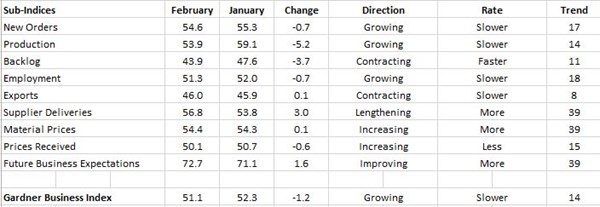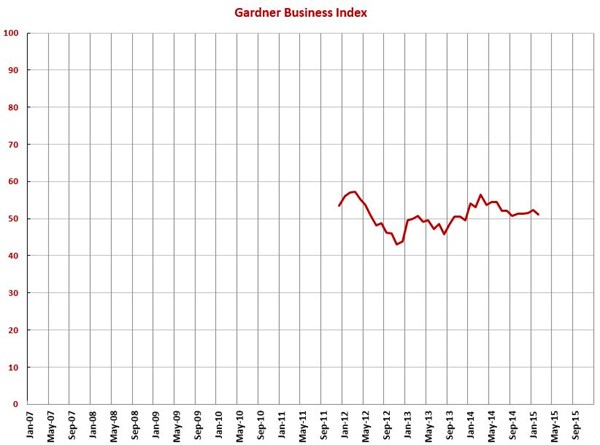February GBI at 51.1 – Six Months of Consistent Growth
This was the first time the index decreased since September, but the fluctuations in the index over that time period have been rather small.
#economics
With a reading of 51.1, the Gardner Business Index showed that durable goods manufacturing grew for the 14th consecutive month and for the 16h time in the last 17months. This was the first time the index decreased since September, but the fluctuations in the index over that time period have been rather small. Essentially, the index has been flat since September 2014. However, compared with one year ago, the index has contracted more than three percent each of the last two months. The annual rate of change has grown at a slower rate for five consecutive months.
New orders grew for the 17h month in a row, and the index is near its highest level since June. The rate of growth has trended up significantly since November. Production expanded for the 14th month in a row. But, the rate of growth dropped sharply from last month. Backlogs contracted for the 11th month in a row. In fact, the index was at its lowest level since September 2013. Compared with one year ago, the backlog index contracted 11.0 percent. That was the third time in four months it has contracted. The annual rate of change peaked six months ago, indicating that the growth in capacity utilization should peak very soon. Employment continued to slow, but the rate of growth has decelerated since November. Exports continued to contract as the dollar continued to strengthen. Supplier deliveries were lengthening at their fastest rate in nearly three years. Materials prices increased at the same rate as last month, which was the slowest rate of increase in nearly two years. Prices received were essentially unchanged from last month. Price increases have gotten smaller and smaller since the summer of 2014. Future business expectations improved slightly in February.
The index slowed in February because the business conditions at large plants were not as strong as previous months. Plants with more than 250 employees had their lowest index since December 2013. Plants with 50-249 employees still had strong growth, but it was slower than last month. However, facilities with 20-49 employees saw faster growth for the second month in a row. Facilities with 1-19 employees contracted for the second month in a row, but the rate of contraction was slower.
After contracting last month, the West was the fastest growing region in February. Also, growing were the North Central – East, North Central – West, and Northeast regions. The Southeast contracted after growing the previous three months. The South Central continued to contract faster due to the drop in oil prices.
Aerospace and medical were neck and neck as the fastest growing industries this month. They were followed by petrochemical processors, automotive, custom processors, primary metals, industrial motors/hydraulics/mechanical components, and metalcutting job shops. Industries that contracted this month included plastics/rubber products, machinery/equipment, electronics/computers/telecommunication, pumps/valves/plumbing products, and forming/fabricating (non-auto).
In addition to the overall durable goods index, we compute indices for a number of technologies or processes. The moldmaking industry grew at the fastest rate this month. It was followed by finishing, screw machining, metalworking, and composites. Only plastics contracted this month.
Planned capital expenditures contracted month-over-month for the sixth straight month and the seventh time in eight months. The annual rate of change has contracted each of the last four months.


RELATED CONTENT
-
MTU Research to Boost Fuel Economy ~20%
Researchers are using V2X communications and other methods to provide vehicles with a significant increase in fuel economy.
-
On Quantum Navigation, EVs, Auto Industry Sales and more
Sandia’s quantum navi, three things about EVs, transporting iron ore in an EV during the winter, going underwater in an EV (OK, it is a sub), state of the UK auto industry (sad), why the Big Three likes Big Vehicles, and the future of logistics.
-
Auto vs. Tech: Guess Who Wins
Matthew Simoncini, president and CEO of Lear Corp., provided some fairly compelling figures this week at the CAR Management Briefing Seminars that show just how out-of-whack the valuations of tech companies are vis-à-vis auto companies.


.JPG;width=70;height=70;mode=crop)